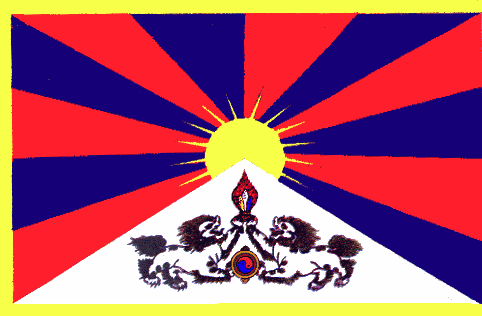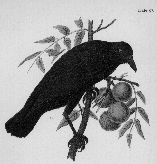
JCROWS.COM

|
|

The Symbolism of the Tibetan National Flag
1. The White snow mountain in the center depicts the land
of the
great nation of Tibet.
2.The six red rays emanating from the sun symbolize the six original peoples of Tibet: the Se, Mu, Dong, Tong, Dru, and Ra.
3. The blue rays symbolize the commitment to spirtual and secular rule.
4. The pair of snow-lions symbolize the complete victory of the spiritual and secular rule.
5. The three-sided yellow border reresents the flourishing
of the Buddha's teachings. The side without a border represents Tibet's
openness to non
Buddhist thought.
6. The raised jewel symbolizes Tibet's reverence for the
three Precious Gems:
the Buddha, the Dharma and the Sangha.
Explanation from Sönam Tenzin:
"At that time, it is recorded that the regiment of Yö-ru tö had a military flag with a pair of snow-lions facing each other; that Yä-ru mä had a snow-lion with a bright upper border; that of Tzang Ru-iao, had a snow-lion standing upright, springing towards the sky; and the flag of ü-ru tö had a white flame against a red background, and so forth. In this way. the regiments of each area had its own individual military standard. Continuing with that tradition up to the beginning of the twentieth century, various regiments within the Tibetan army have had military flags with either a pair of snow-lions facing each other, or a snow-lion springing upwards and so forth.
"In the latter part of this period, during the rule of His Holiness the Great Thirteenth Dalai Lama, this eminent spiritual and temporal ruler of Tibet enacted many modifications in administrative policies in accordance with international customs. Based on the formats of previous Tibetan military flags, His Holiness improved upon them and designed the present, modern national flag. With an official proclamation, He declared that this would be the uniform, standard flag to be adopted by all Tibetan military defence establishments. Since the time of that proclamation, all Tibetan regiments have likewise adopted this flag as their standard.
"The colour scheme of the Tibetan national flag gives a clear indication of all aspects of Tibet in its symbolism such as the geographic features of the religious. snowy land of Tibet, the customs and traditions of Tibetan society, the political administration of the Tibetan government and so forth.
"History attests to the fact that Tibet is one of the most ancient nations of the world. Therefore, in all the three regions of Tibet, irrespective of caste and creed, this national flag inherited from our ancestors is universally accepted as a common, peerless treasure and even today still continues to be highly respected and esteemed as in the past."
Quoted from "Tibetan National Flag" © Copyright 1980 Library of Tibetan Works and Archives.
http://buddhism.kalachakranet.org/chinese-orchestrating-riots-tibet.htm
Britain's GCHQ, the government communications agency that electronically
monitors half the world from space, has confirmed the claim by the Dalai
Lama that agents of the Chinese People's Liberation Army, the PLA, posing
as monks, triggered the riots that have left hundreds of Tibetans dead
or injured.
Posted Mar 28, 2008 12:20 PM PST

Sleep and the Inner Landscape,
An Interview about
Dreams and Tibetan Medicine with
the Tibetan Physician, Dr. Yeshe
Dhonden
|
|
|
|

"Tibetan incense, medicinal powder, and
Tibetan 'precious pills' are in
great demand here," said one police officer who asked not to be
named.
"People believe that it can prevent the virus. And SARS hasn't spread
to Tibet."
Radio Free Asia-May 7, 2003
|
|
|
|



Handbook of Traditional Tibetan Drugs: Their Nomenclature,Composition, Use and Dosage

 |
 |
|
|
|
|

The Household
Physician
How Scientific Is Modern
Medicine?
Return to JCROWS.COM
J.Crow Company
PO Box 172
New Ipswich, New Hampshire 03071
USA
Fax or Phone
1-800-878-1965 (US & Canada)
603 878 1965 (All Others)
Contact Us: jcrow@jcrow.mv.com